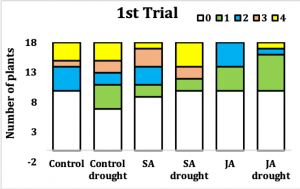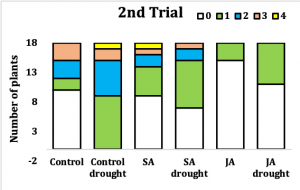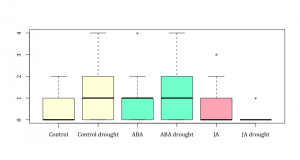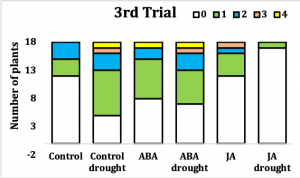Final report for GNE18-189
Project Information
Disease pressure is likely to increase in the future due to the rise in temperatures and extreme weather events. This will have major impacts on the sustainability of disease management, since management of viral diseases of crops is highly dependent on environmental conditions, as viruses are dependent on their plant host’s physiological machinery to multiply and cause disease. However, there is knowledge gap in how disease dynamics in specific crops like tomatoes is likely going to be affected by unpredictable weather patterns and by atypical dry and rain spells in a region like the Northeast. Therefore, it is imperative to find a proper management system that is sustainable and reduces economic losses.
The goal of this project was to determine the roles of phytohormones on disease progression/inhibition under prolong drought stress and also if drought stress itself helps in disease occurrence. We have applied Jasmonic acid (JA) and Salicylic (SA), being well known signaling molecules for biotic stresses and Abscisic acid (ABA), the major regulatory phytohormone in abiotic stress on Tomato under TSWV infection and drought stress. Application of JA showed reduced disease incident and severity under both control and drought stress than their corresponding controls. On the other hand, SA didn’t show any signification changes in terms of severity, though disease incident was lower than its counter control under drought stress. However, under control condition (with water), application of SA increased the disease incident. ABA didn’t show to play any crucial role on disease inhibition under both control and drought stress. We have also found that dehydration state helps in disease progression as incident and severity were always higher drought treatment than the control.
Our research has shown that the utilization of phytohormones to reduce disease occurrence and progression under drought stress is a feasible option. Since viruses are usually managed by application of insecticides used to reduce the number of insect vectors, our alternative strategy would reduce the spray of pesticides, would reduce environmental impact and help sustainable agricultural practices in the field. Because phytohormones strengthen the plant defense system, rather than act directly on the pathogens or vectors, their utilization would reduce the insurgence of resistant pathogens or insect resistance against insecticides.
The following objectives expand my Ph.D. thesis research on TSWV evolution under increased temperature, and on the elucidation of the mechanisms underlying the interactions between phytohormones and plant resistance to TSWV infection.
The specific objectives of this proposal are:
1. To determine the effects of climate change on disease progression
a. What is the effect of temperature on disease progression in tomato?
b. What is the effect of drought stress on disease progression in tomato?
2. To determine the effect of phytohormones on disease progression in tomato
a. What is the effect of exogenous methyl jasmonate/jasmonic acid (JA) on disease progression in tomato?
b. What is the effect of exogenous methyl salicylic acid (SA) on disease progression in tomato?
c. What is the effect of exogenous abscisic acid (ABA) on disease progression in tomato?
The purpose of this project is to provide new tools to alleviate crop disease impact associated with climate change which will in turn increase food security and decrease economic losses. Phytohormones will be explored as a tool for sustainable management of tomato diseases in the Northeast.
Many studies claim that disease pressure is likely to increase in the future, if there continues to be a rise in temperatures and extreme weather events (Anderson et al. 2004), but not many studies have looked at the disease dynamics in specific crops such as tomatoes in a region like the Northeast, that is likely going to be more affected by unpredictable weather patterns and by atypical dry and rain spells, as well as increased winter temperature (Alexander et al. 2015). If increased disease pressure occurs, it will have major impacts on the sustainability of disease management. According to the Environmental Protection Agency, the Northeast is beginning to experience longer, hotter, and drier summers along with warmer winters. Logically, warmer winters and summers could potentially allow pest and pathogen vector (mainly insects) populations to rise and make earlier appearances, leading to an increase in pesticide sprays. In addition to effects on insect vectors, management of viral diseases of crops is also highly dependent on environmental conditions, since viruses are dependent on their plant host’s physiological machinery to multiply and cause disease, and plant hosts in turn depend upon the environment for physiological function.
Viruses in the family Tospoviridae, including Tomato spotted wilt orthotospovirus (TSWV), cause disease on more than 1,090 plant species in 84 families (Parella et al. 2003) and have a negative impact on crop and ornamental production in many areas of the world. These viruses have a potential to cause more damage as climate continues to change since the range of their vectors is going to move and expand. Management of tospoviruses relies mainly on plant resistance and insecticide treatments (Riley and Pappu 2004). Unfortunately insecticide treatments rapidly cause thrips to evolve resistance in the field due to high selective pressures (Wang et al. 2016; Zhao et al. 1995). Climate change may also exacerbate resistance evolution in thrips due to accelerated developmental rate at higher temperatures, so other management tactics may be necessary to adequately reduce disease incidence.
Phytohormones, often referred to as biostimulants in agriculture, broadly, are hormones produced by plants that regulate growth and defense against pathogens (Pieterse et al. 2009) and are promising targets for resistance breeding against plant diseases. Two of them, jasmonic acid (JA) and salicylic acid (SA), are involved as part of a biotrophic pathogen plant response (e.g. plant viruses), and of herbivore or necrotroph response, respectively (Pieterse et al. 2009). Abscisic acid (ABA) is generally produced as response to osmotic stress and drought (Singh et al. 2011), but recently, it has been recognized to have also a role in pathogen and virus defense (Alazem et al. 2014; Alazem et al. 2017; Westwood et al. 2013).
There exists a large body of literature estimating the impacts of climate change, yet in reality we have a major lack of knowledge on what the exact impacts of increased temperatures and drought conditions will have on crop disease management. The Northeastern IPM Center recognizes climate change and pests as one of its five signature programs (http://www. northeastipm.org/grant-programs/stakeholder-priorities/). Their advisory board consists of stakeholders, thus the study of climate change is important to growers who are invested in integrated pest management (IPM). They call for more research on the impact of climate change on the distribution and occurrence of pests. Pathogens can be considered a crop pest and often are vectored by insect pests, so changes in disease pressure due to climate change and building of climate resilience through specific IPM disease management strategies is also imperative.
TSWV provides a great model system to test the effects of climate change on disease development and to deploy novel virus disease management strategies. Tospoviruses, such as TSWV, Iris yellows spot virus of onions and Impatiens necrotic virus, are major viruses that limit crop productivity in field and greenhouse throughout the world, and TSWV, the largest virus problem on tomato in warmer US states such as Florida, California and Georgia, is poised to become a larger problem to growers in the Northeast, since it is vectored by thrips that are present in the Northeast and already cause economic losses, especially in greenhouses.
Abscisic acid is an important factor in pathogen resistance. Preliminary data from our lab show that genes in the ABA pathway respond to TSWV infection and are responsible for disease outcome: i.e. infection vs. no infection. JA and SA are well-known for their roles in plant defenses. However, they are tightly linked with ABA and other phytohormones that respond to environmental variables, and their efficacy may change as the climate does. This study will elucidate if TSWV and other virus pathogens will become a more severe problem in the Northeast due to climate change, and will provide phytohormone-based strategies for virus disease management, at different temperatures and drought stress.
Research
During the first months of this project, we purchased and received materials and supplies necessary to conduct the proposed objectives. Aside from standard lab supplies, we have obtained tomato seeds, the 5 hygrometers for testing soil moisture (Objective 1), and the phytohormones Methyl Jasmonate (Me JA), Salicylic acid (SA), and Abscisic acid (ABA) necessary to conduct Objective 2.
For Objective 1, we have conducted tests to verify the wilting point of tomatoes under drought stress. In order to accomplish this result, we have decreased the amount of water in pots of tomatoes that have reached the two true-leaves stage, and we have monitored the soil water potential and wilting symptoms of healthy plants.
We have also conducted a total of 3 trials with JA, 2 with SA, and 1 with ABA to determine the difference in infection rate of 18 tomatoes sprayed with these hormones, and inoculated with Tomato spotted wilt virus (TSWV), compared to the one of 18 tomatoes sprayed with buffer only and inoculated with TSWV (Objective 2). The number of trials was higher for treatments that showed increased in virus resistance and lower for treatment that did not alter disease severity or incidence. We have also carried out the same experiments mentioned above with the hormones and TSWV under drought stress. The infectious status of the inoculated plants was evaluated by recording the incidences and severity of symptoms and confirmed by ELISA. Severity of symptoms was measured on a scale from 0-4 with 0 means no symptom and 4 means completely wilted plant. Plants were considered positive by ELISA if the O.D. values (optical density) of the samples collected from them had three times the value seen in the negative controls.
The goal of this project was to determine the roles of phytohormones on disease progression/inhibition under prolong drought stress and also if drought stress itself helps in disease occurrence. We have applied Jasmonic acid (JA) and Salicylic (SA), being well known signaling molecules for biotic stresses and Abscisic acid (ABA), the major regulatory phytohormone in abiotic stress on Tomato under TSWV infection and drought stress. Application of JA showed reduced disease incident and severity under both control and drought stress than their corresponding controls (Figure 1, 2, 3, and 4).
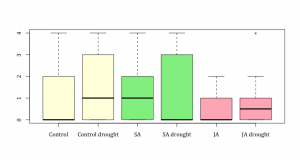 Figure 1: Boxplot for disease severity. X-axis indicates the treatments and Y-axis indicates the severity on a scale 0-4
Figure 1: Boxplot for disease severity. X-axis indicates the treatments and Y-axis indicates the severity on a scale 0-4
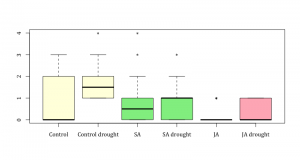 Figure 2: Boxplot for disease severity. X-axis indicates the treatments and Y-axis indicates the severity on a scale 0-4
Figure 2: Boxplot for disease severity. X-axis indicates the treatments and Y-axis indicates the severity on a scale 0-4
Figure 3: Disease incidence and severity graph, Trial 1. Y-axis indicates the number of plants, legends indicate the severity on a scale 0-4
Figure 4: Disease incidence and severity graph, Trial 2. Y-axis indicates the number of plants, legends indicate the severity on a scale 0-4
On the other hand, SA didn’t show any signification changes in terms of severity (Figure 1 and 2), though disease incident was lower than its counter control under drought stress (Figure 3 and 4). However, under control condition (with water), application of SA increased the disease incident (Figure 3 and 4). ABA didn’t show to play any crucial role on disease inhibition under both control and drought stress (Figure 5 and 6).
Figure 5: Boxplot for disease severity. X-axis indicates the treatments and Y-axis indicates the severity on a scale 0-4
Figure 6: Disease incidence and severity graph, Trial 3. Y-axis indicates the number of plants, legends indicate the severity on a scale 0-4
ABA gets elevated under oxidative stress conditions and it acts antagonistically with both JA and SA. Our data found that, application of ABA didn’t diminish the disease level. This is because, higher level of ABA produced as consequence of oxidative stress caused by drought and of exogenous foliar application reduced the level of JA which was shown to be involved in TSWV disease inhibition. Thus, application of ABA would not be effective against TSWV infection. This is also true for SA application on plants under drought.
We have also found that dehydration state helps in disease progression as incident and severity were always higher drought treatment than the control.
Our research has shown that the utilization of phytohormones to reduce disease occurrence and progression under drought stress is a feasible option. Since viruses are usually managed by application of insecticides used to reduce the number of insect vectors, our alternative strategy would reduce the spray of pesticides, would reduce environmental impact and help sustainable agricultural practices in the field. Because phytohormones strengthen the plant defense system, rather than act directly on the pathogens or vectors, their utilization would reduce the insurgence of resistant pathogens or insect resistance against insecticides.
Education & Outreach Activities and Participation Summary
Participation Summary:
One conference abstract was published: Walls, III, J., & Rosa, C. (Supervised Student Author, 100%) (2018). Involvement of hormone pathways in early onset of TSWV resistance. Phytopathology. (108, 228).
One poster was presented at an international conference: Walls, J. T., & Rosa, C. (Author and Supervisor of Student First Author). (2018). "Involvement of hormone pathways in early onset of TSWV resistance," 2018 ICPP Meeting, American Phytopathological Society, Boston, MA, Accepted. National.
One talk was given at the Virology@PSU in November 2018.
One poster will be presented at the Gamma Sigma Delta sponsored undergraduate students poster competition at Penn State in Spring 2020.
One article will be submitted for publication in Summer 2020.
Project Outcomes
Disease pressure is likely to increase in the future due to the rise in temperatures and extreme weather events. This will have major impacts on the sustainability of disease management, since management of viral diseases of crops is highly dependent on environmental conditions.
Our research has shown that the utilization of phytohormones to reduce virus disease occurrence and progression under drought stress is a feasible option. Since viruses are usually managed by application of insecticides used to reduce the number of insect vectors, our alternative strategy would reduce the spray of pesticides, would reduce environmental impact and reduce the cost due to the purchase and utilization of insecticides. Because phytohormones strengthen the plant defense system, rather than act directly on the pathogens or vectors, their utilization would reduce the insurgence of resistant pathogens or insect resistance against insecticides and would prolong the efficacy of management strategies against a particular insect or pathogen. The decrease in symptoms severity and incidence associated with the use of phytohormones will reduce economic losses caused by viruses in tomatoes, especially under drought conditions. All these outcomes could have direct effect on agriculture sustainability.
Due to climate changes, we are experiencing more abiotic stresses like drought, heat, salinity etc. This project helped us to gain knowledge on how drought stress can increase disease occurrence and how phytohormones can be utilized to restore plant defenses against viral diseases. To apply sustainable agricultural practices, we need to know if and how these changes affect disease progression rate over the course of time. Our data showed that, foliar application of JA on plants reduce TSWV infection and can become part of sustainable agricultural management practices. To our knowledge, this is the first study to link the management of virus diseases in agricultural settings under changing climate scenarios to the use of phytohormones. For the remaining part of my Ph.D. studies I intend to continue to work on improving plant health by the administration of biostimulants that boost plant defenses against biotic and abiotic stresses. I also plan to elucidate some of the plant pathways involved in this phenomenon. My results will justify the use of biostimulants as sustainable tools to fight plant diseases and to better respond to the challenges posed by climate change. So far, this research has resulted in the granting of two student research fellowships to our lab by the Penn State College of Agricultural Sciences, that helped expanding this research project by funding an undergraduate student for two semesters.
The future direction of this research would be to elucidate the mechanism behind the success of the use of phytohormones to counteract the increase of disease incidence caused by drought. This could be done by measuring differential expression of several genes from the JA, SA and ABA pathways under drought and phytohormone applications. Molecular data on gene expression along with our phenotypic data could be used to help in managing virus diseases under climate change scenarios.
